We had a nice long winter, down here in Texas, that had enough chill hours for my fruit trees. Unfortunately, our bee population in the spring is pretty sparse. I had some hardships that made it impossible to get out and pollinate my pear tree. After I watched all of the small fruit abort I was faced with the next set of flowers in my fruit trees: my peach tree. To bee, or not to bee? I chose to help my tree out. I used the following guide on my peach this spring.
It took maybe twenty minutes to do all of the lower branches. I had a lone bumblebee helping me with the upper branches. I’m sure he (or she) did a much better job than I did! Hopefully, I see some results on the peach. Plant as many bee friendly plants as possible! They certainly need our help. Read on about plant sex, and how you can help, by hand pollinating.
Flowers are beautiful examples of sexual reproduction. We gather them, we create bouquets, we stick our noses into a plant’s sex organs and take a deep breath of intoxicating fragrance.
The idea of sex (at least when we look at our own species) seems to be incredibly more complex and inherently immature.
I will point to plants for transferable lessons in the beauty and enjoyment of sexual reproduction. Because: with flower sex, there are no immature experiences. Enjoying a flower is simple and healthy.
Plant sex: On display
Plants are never shy about reproduction. Those beautiful blossoms on your rose bush? Reproduction. The fruit you enjoy from the market? Reproduction. The nuts that provide fiber and protein in your diet? Reproduction.
Plants can’t walk around and find their ideal mate. Instead they are more like billboards attempting to get pollinators to look so they might entice them to stop by and enjoy some nectar (and to spread some pollen around while they are at it.) With a plant’s sexual reproduction: it is in the plant’s best interest to get noticed (although some trees like pears offer low quality nectar and are often passed over in favor of more nutritious fare. Other trees, like pawpaws, use flies who aren’t very interested or talented pollinators.) Pollinators create new offspring for plants, fruit and nuts attract animals to help with dispersal.
Humans select strains for the best fruit as far as taste and visual appeal. However, we create imbalance in the system when we don’t remember to select to attract and feed pollinators. I believe helping create healthy pollinators is going to become a necessary interest that must be included in the future of breeding and research in horticulture. It will be in recognition of the importance of the balance that nature strives to create.
What is the difference between hybrid and open pollinated seed?
These are legal definitions for plants. If you would like to know how and why these are separated in seed catalogs this is a great explanation: http://www.garden.org/subchannels/care/seeds?q=show&id=293&page=1 You need to know the difference before you start on the pollination journey.
Purposeful hand application of pollen:
As a home gardener, you can effectively focus on two different things in hand pollination. The first is to (1) purposely pollinate plants to create (A) a new hybrid or to (B) isolate and maintain pure strains:
(A) Hybridization (taking pollen from one desirable plant and placing the pollen on a second variety. With this method you are trying to create a better strain than either of the parents) will produce a new type of fruit but the seeds will not be stable. Reliably hybridizing takes more expertise than the average home gardener has. If you allow one of nature’s pollinators to do this you will get something unique next year if you sow the crossed seed (although you may not enjoy eating it.) Letting nature engage in hybridization is like the slot machine gambling of the plant world. You may hit the jackpot growing hybridized seed but more often you may just lose your money (with lesser quality plants than the parents, wasted garden space, water etc). I will admit to enjoying random crosses that grow out of discarded winter squash seed in my compost heap. Even if it’s merely to marvel at the possibilities that plant genetics can offer us!

(B) Keeping plant strains pure: The other part of this type of pollinating is isolating varieties to prevent hybridization. You will need isolation space (which varies per plant type), grow only one variety or use barriers like bags to keep what you have pollinated fertilized by only what you have chosen to place on it. You can try this if you have had a few successful seasons in your home garden and feel ready to expand your skills. You can learn more about keeping open pollinated seed strains pure or creating new hybrids here: http://www.seedsavers.org/Education/Seed-Saving-Resources
If you are a seasoned gardener, I suggest this site: http://seedalliance.org/index.php?mact=DocumentStore,cntnt01,download_form,0&cntnt01pid=12&cntnt01returnid=139
(I always encourage people to support open pollinated seeds through seed banks like seedsaver.com They are a genetic bank for open pollinated and heirloom strains of vegetables, grain and flowers. They are maintaining diversity which is in complete opposition to GMO and hybrid seed companies like Monsanto.)
The second part is 2) Lack of pollination: The second focus in hand pollination is to make up for a lack of pollinators. No bees is a big deal! When sexual reproduction in a vegetable or fruit garden is bee reliant, you can intervene if there is a lack of bees. Just make sure you add bee attracting flowers that will bloom throughout the next season. You aren’t going to want to have to totally replace the bee’s handiwork. They work hard!
Where we fit in:
Just like humans can sometimes use help with fertility: plants that use sexual reproduction can use our help as well. Male and female organs on a plant use pollination to reproduce. Here is a list of common vegetable plants and how they reproduce: http://www.harvesttotable.com/2009/05/how_vegetables_are_pollinated/
There are three main categories of pollination and gardeners can easily affect them:
A: Pollination by wind. This happens between separate male and female flower parts found on plants like corn (how to hand pollinate corn: link) You can help these plants along by physically rubbing the male pollen onto the female flower to increase your chances of fertilization. You can specifically help corn by cutting off one of the tassels (located at the top of the plant)
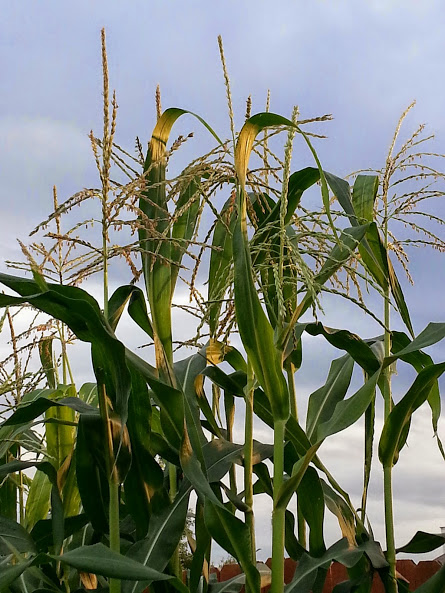
and knocking pollen onto the silks as they emerge (found closer to the middle of the plant).
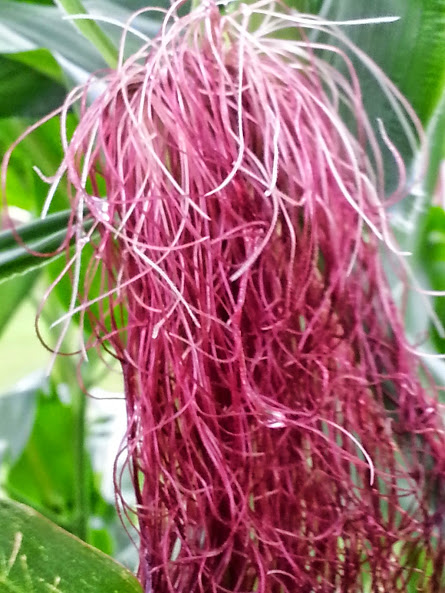
B: Self-pollination: This happens within the same flower like tomatoes (how to hand pollinate tomatoes: link ) The key for these plants is agitation: grab a stem and give the plant a good shake. It is a little like what a good wind or rain storm would do. Self pollinating plants have their male and female parts close together. The pollen needs to drop a very small distance onto the stigma. Grabbing the plant and giving it a good shake will help knock loose pollen from the anthers onto the stigma.

C. Animal pollination. Where a plant relies on something in the animal kingdom to spread pollen from plant to plant. Examples are bees, butterflies, moths and other insects pollinating your home vegetables and fruit trees. Here is a list of plants and their pollinators: link
Ideally you have a ton of bees in your yard from avoiding insecticides and other chemicals while ensuring you plant nectar and pollen rich flowers. This should create conditions to assure that you have pollinators already on your property eager to pollinate your fruits and vegetables. Even so, early in our season we are short on pollinators. Unfortunately, most suburbs are surrounded by miles and miles of a monoculture of lawn grass. Homeowners struggle to keep weeds out of their lawns just so neighbors (or an HOA) don’t judge them for noncompliance. While homeowners are planning their herbicide attack they don’t notice the hum of bees enjoying those same weeds.

I hope within the next decade we start looking at the ground around our homes as the potential to support nature rather than trying to enforce an arbitrary idea of beauty. Humans seem to enjoy battling the way things work in nature by forcing the unnatural concept of perfectly manicured lawns. Try removing as much grass as possible and replacing it with pollinator friendly, native plants.

When does it make sense to hand pollinate?
Cucurbits are number one on this list of home fruiting plants that have issues with pollination. Cucurbits include: winter squash (which includes pumpkins), summer squash, melons, cucumbers and gourds. They produce large fruits on a bush or a long sturdy vine. If you have struggled getting these plants to produce for you, it may be time to start looking at pollinating the flowers yourself.

Identifying male and female flowers on cucurbits:
In the cucurbitae family there are separate male and female flowers. Once you can tell the difference between the sex of a flower, you can try your hand at pollinating.

These are the male flowers. They are easy to identify because they will be on the end of a long straight stem and covered in pollen. The male part of the flower is called the stamen. There will be a long filament that has a pollen covered anther at the end.

At the end of the stamen is the anther. This is where you start. The anther is where the pollen (which is male) is found that is required for the female flower to produce fruit.

This is the female counterpart. You can spot female flowers by looking for the swollen ovary.

These will abort and fall from the plant if they are not fertilized properly.


Like most living things: the female reproductive organs are more complicated than the male organs. The entire length of the female part of a flower is called a pistil. Starting from where the pistil is attached to the base of the flower you will see a swollen area which is the ovary. It is full of potential seeds called ovules. Continuing up the pistil there will be a narrower tube called the style connected to the sticky tip of the pistil: the stigma. This sticky tip is what needs to be fertilized with the male pollen.

Here is a simple description that will give you a working foundation in hand pollination:
You don’t need to work with hundreds of flowers, just a few per vine. If they fail, go out and do it again, until you have the amount of fruit you are after. You will get better quality, larger fruit if you allow your plant to concentrate on only producing a few fruit per vine.
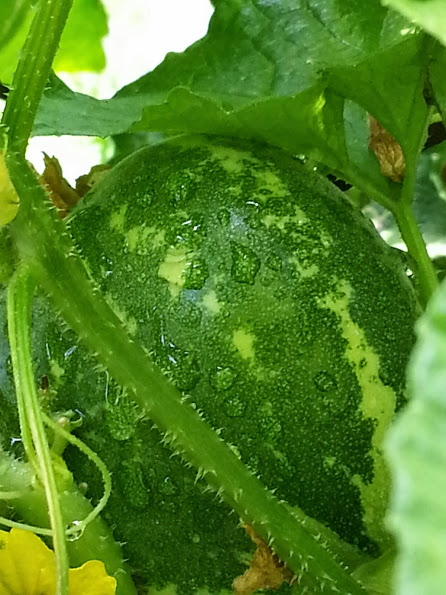
If you have to stand in for bees frequently, you will realize how much work these little garden friends do for us. I recommend making plans to plant nectar and pollen rich plants so you can attract these busy bees to your yard and save yourself the trouble of trying to do it all yourself.

The following is how I like to hand pollinate in small areas with large fruited plants:
I use a q-tip to gather and spread pollen. They are cheap and simple. I twirl it over several of the same species/variety of squash or melons. This is Thai Golden Round. Then I hunt for open female flowers and twirl the pollen onto the stigma. If you’ve done it correctly: the fruit will begin to grow and mature. If your attempt fails: the immature fruit will fall from the vine. You will have more chances and this is why I save and label my q-tips: I want to load as much pollen on them as I can. You can also use a small paintbrush or remove the male flower completely and rub it’s anther directly onto the female’s stigma.
You don’t need to be careful if you aren’t saving seed, but you won’t create a squash with watermelon pollen. You still need to focus on one species of plant, even if you choose to mix varieties of pollen from the same species of plants. Here is a good explanation of cross-pollination in cucurbits: http://www.walterreeves.com/food-gardening/squashpumpkincucumberwatermelon-pollination-explanation/
You can label your q-tip by putting a piece of tape on it and writing the variety you used it on. If you aren’t saving seed you can use the same q-tip for all of your pollinating (I am not currently saving seed because I am trialing too many, in too close of proximity, to keep the strains pure. Although I usually keep at least one q-tip for each: winter squash/summer squash, melon, watermelon etc. In this way I make sure the q-tip only contains pollen that will fertilize the species I am trying to grow.)
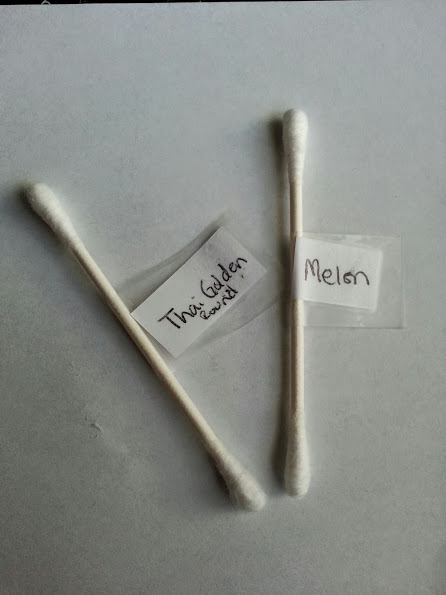
For more information including recipes, pictures and growing information: Here are some great links.
Learn all about melons: (This is a fantastic site out of Australia that includes growing information, recipes and reviews of melon varieties.) http://melonmaster.yolasite.com/
Learn all about squash: This site can take a while to load but it has reviews and recommended ways to prepare and consume pretty much any variety of squash, gourd and cucumber that you are growing. The site is listed alphabetically.) http://www.thenibble.com/reviews/main/vegetables/squash-glossary.asp
There you go! A simplistic guide to an incredibly complex field of study. Botanists can write the text books full of the complex how’s and why’s, but anyone with this simple guide can go out and enjoy becoming the bee!









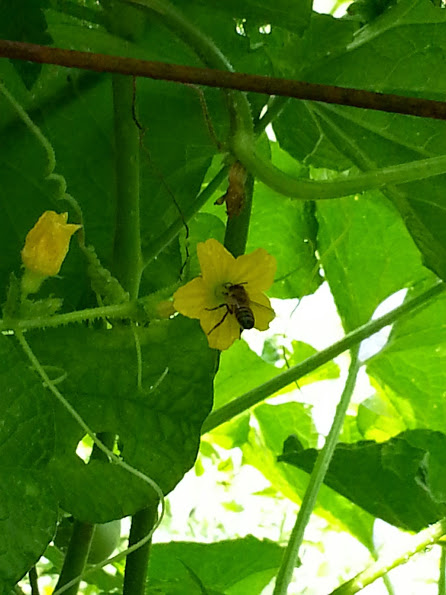

I’m actually starting to dig up grass and see what replaces it. If I could get my boyfriend out of the mindset that we need a “perfectly manicured lawn” I’d be oh so happy…but he keeps mowing stuff down, even stuff I’ve asked him not to mow 😞 Thanks for all the advice! Holly (I’ve started putting rock and mulch down in areas I don’t want him to mow!)
My husband has to be walked through the yard before he mows so I can point out what is and isn’t supposed to be in our yard. He is definitely not a gardener, but he’ll mow our 1/4 acre lot, in 100 degree heat, so I can’t complain! Thanks for coming by! I’m glad you enjoyed the post!
I’m in Colorado and our low last night (July 2nd) was 40 degrees. That is 8 degrees above freezing. We have problems with pollination because our poor bees have such a hard time at 8,500 ft altitude. We can’t take their honey, because they have so little that they won’t make it through the winter. I love this post. People don’t realize how important bees are. I’ve been considering a bee hive on my farm, simply to encourage them to live here and pollinate my garden. Great post!